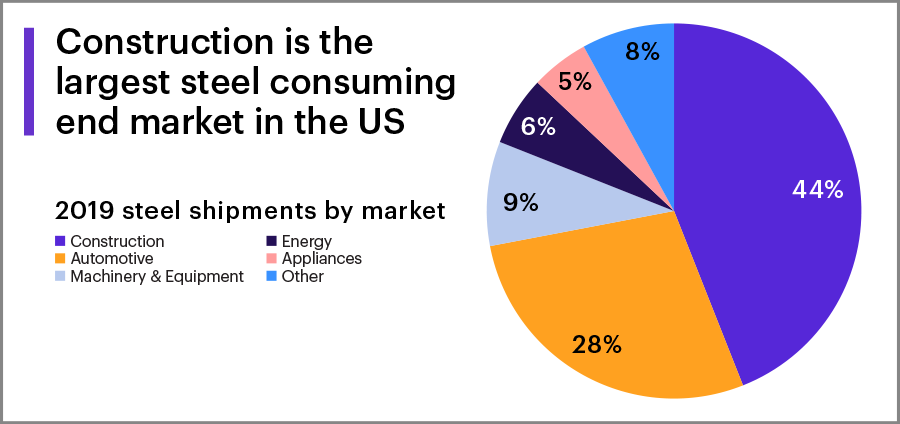Paving the way for a US infrastructure supercycle
Insights from Morgan Stanley Research
05/27/21Why the Biden administration’s infrastructure plan could spark a decade-long supercycle for building materials, spilling over to the rest of the US economy. Six takeaways for investors.
After decades of underinvestment, US roads, bridges, ports, airports, and transit systems could be closer to getting their own shot in the arm, with the introduction of the Biden administration’s ambitious infrastructure package.
Despite the greater focus on elements related to clean energy and electric vehicles, the old-fashioned infrastructure and building materials—think concrete and asphalt roads, steel for bridges—could deliver a significant economic impact.
Morgan Stanley’s Research team examined which types of structures need repair, areas of the market that may directly benefit, and how this might spill over to the rest of the economy—laying the groundwork for investors eyeing related stocks.
Here are six takeaways from their analysis of the infrastructure package.
1. Core infrastructure has a high probability of passing
The infrastructure package, currently one of four major categories outlined in the American Jobs Plan (AJP), includes investing in: traditional infrastructure, environmental infrastructure, technology research and development, and social programs.
Many hurdles remain for the deal to get done before the end of the third quarter; however, Congress currently seems inclined to make progress on traditional infrastructure. “As it stands today, we believe an infrastructure plan, at levels close to the Moving Forward Act, is more likely," said Michael Zezas, Head of US Public Policy Research, referring to the 2020 House bill that stalled in the Senate. That bill targeted fixing existing infrastructure before constructing new roads and bridges, with more immediate impact on local economies.
2. A new supercycle ahead
If passed, a core infrastructure package could drive demand for building materials, including cement, sand, gravel, and possibly steel, and boost the revenues of manufacturers. Led by major investment in concrete, heightened demand would outstrip production capacity and drive higher pricing.
Work conducted by AlphaWise, the proprietary survey and data arm of Morgan Stanley Research, mapped $3 trillion in needed infrastructure repairs, breaking down to about $398 billion for concrete bridges, $796 billion on concrete roads, $300 billion for steel bridges, and $1.6 trillion to upgrade asphalt roads:
3. Cement may be the primary beneficiary
The single biggest beneficiary of a traditional infrastructure package may be cement. With the US cement industry at 90% production capacity and 30% import capacity, prices could be pressured materially higher, which could potentially double US cement earnings over the next five years.
Infrastructure spending would also require about nine billion metric tons of aggregates—or the equivalent of about four years of demand—with highway resurfacing driving the largest demand.
4. Steel also stands to benefit
Construction is one of the largest end-markets for finished steel products in the US, accounting for nearly 44% of annual domestic steel shipments.
Industry sources estimate that every $1 billion dollars spent in infrastructure translates to approximately 50 kilotons of steel demand. Using this rough estimate, a $1.5 trillion, 10-year infrastructure plan could translate to 75 metric tons of incremental steel demand over 10 years. Although rebar (the steel reinforcing rods in concrete) may benefit the most, thanks to strong cement consumption, demand for steel may ultimately depend on the type of projects included in the final infrastructure package. For example, wind turbine towers use about 200 tons of steel per tower, and electrical grids use 30 to 35 tons per mile.
5. Construction stocks may get a boost
Infrastructure spending bodes well for domestic construction stocks across the board. When the construction industry is underwritten by the federal government, it typically helps lower investment risk and gives industries pricing power, improving profitability and the risk-reward profile for construction materials. Moreover, the infrastructure program will likely emphasize repairs over new infrastructure, providing a higher return on investment.
6. Infrastructure’s multiplier effect
The infrastructure package would likely ripple well beyond building products. In fact, Morgan Stanley economists see widescale productivity benefits from a large infrastructure package. A $1 trillion, 10-year package could add 0.2 percentage points to GDP in subsequent years and 715,000 jobs over 10 years. “Add to this the potential boost from fiscal stimulus and it could add as much as 0.4 to 0.8 percentage points to annual GDP growth rates," said Ellen Zentner, Morgan Stanley Chief US Economist.
Zentner noted that the increased public investment in infrastructure could provide even longer-term tailwinds for the US economy. “The current body of literature on government multipliers finds that infrastructure spending policies carry multipliers as high as two times. In other words, each fiscal dollar increases gross output by two dollars."
Bottom line: We’re still a long way from a done deal—there will likely be a great deal of political haggling before we know what the final product will look like—but the proposals nonetheless hint at where a new leg of economic growth may come from. For investors, it also presents some interesting considerations for related areas of the market. Of course, any decisions should ultimately reflect individual goals, timelines, and risk tolerance.
How can E*TRADE help?
Brokerage account
Investing and trading account
Buy and sell stocks, ETFs, mutual funds, options, bonds, and more.
Review your portfolio’s performance
Use our interactive charts to view your rates of return over various time periods and compare your portfolio against multiple benchmarks.

